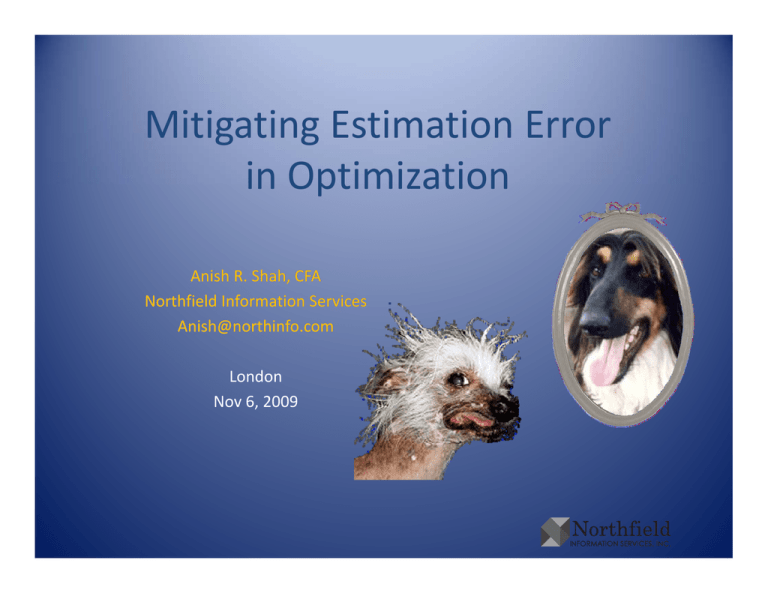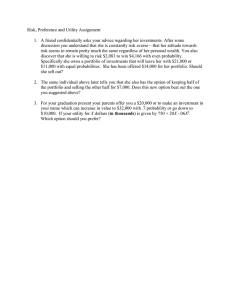Mitigating Estimation Error in Optimization
advertisement

Mitigating Estimation Error in Optimization in Optimization Anish R. Shah, CFA Northfield Information Services Anish@northinfo.com @ London , Nov 6, 2009 Background in 1 Slide Background in 1 Slide • For the purpose of construction, value is measured by a single number, portfolio utility, which typically is return penalized for risk • Optimizers find the portfolio weights that maximize this utility • Alas, inputs into utility are only estimates • Optimized portfolios perform worse than their forecasted utility and may look funny Purpose of Talk Purpose of Talk • Disabuse the false precision of portfolio utility sabuse t e a se p ec s o o po t o o ut ty and optimal portfolio weights • Describe fundamental mechanism that causes dissatisfaction with optimization and how to avoid it • Briefly introduce two recent estimation error adjustment features in Northfield Optimizer An [Easy‐to‐Graph] An [Easy to Graph] Example Example • Recall familiar Markowitz utility function eca a a a o t ut ty u ct o Utility = return – λ × variance • Allocate money across 2 stocks – Forecast returns o ecast etu s • r1 = 9% ± 1% • r2 = 10% ± 1% – FForecast correlation ρ t l ti = 0.4 ± 0 4 0.2 02 – (For simplicity) Std deviations are known to be 30% – User User’ss risk aversion λ = 1%/200% risk aversion λ = 1%/200%2 Reference: Propagation of Errors Reference: Propagation of Errors • Suppose f is a function of variables known with uncertainty – f = f(x) = f(x1, …, xn) • Linearly approximate f in the area of interest, around the y pp , point x0 – f(x) ≈ f(x0) + f(x0) (x ‐ x0) • To approximate the error in f, take the variance – var[f(x)] ≈ f(x0) var(x) Tf(x0) • An aside: this is the idea behind linear factor risk models Utility U Utility r1 = 10 ± 1 r2 = 9 ± 1 ρ = 0.4 ± 0.2 σ = 30 λ = 1/200 • Utility ranges from 4.5 – 5.6 • Error is ~ 1 ± 0.1 7 6.5 6 5.5 5 45 4.5 4 3.5 3 • Differences in utility are on par with the error p • Many combinations are indistinguishably good indistinguishably good 0% 25% 50% 75% % Invested in Stock 1 100% • No single “Optimal Portfolio” Bonus Slide: Sources of the Error f h 1.4 Error in U Utility 1.2 1 08 0.8 Total 0.6 from r1, r2 0.4 from ρ from ρ 0.2 0 0% % 25% % 50% % 75% % 100% % % Invested in Stock 1 r1 = 10 ± = 10 ± 1 r 1 r2 = 9 ± = 9 ± 1 ρ 1 ρ = 0.4 ± = 0 4 ± 0.2 02 Two Bowls of Baked Beans Two Bowls of Baked Beans Wise monkey says, “They are nearly the same; the second has a bit more onion.” Confused monkey says, “They’re entirely different; they don’t share a single bean in common.” • Many papers on estimation error in portfolio optimization are written by confused monkeys – Mistakenly focus on differences in holdings rather than the difference in portfolio utility No Single Optimal Portfolio Many, of Vastly Different Composition A. B. C. Markowitz utility function uses only 2 features – return & covariance Securities are similar, particularly in their forecasts Of course the optimal portfolio’s composition is sensitive to the inputs, but its utility isn’t After changing a return forecast confused monkey screams “Optimization After changing a return forecast, confused monkey screams, Optimization is too sensitive to the is too sensitive to the inputs!” – – Anthropomorphizes software and calls it an ‘evil‐doer’ Kicks computer Wise monkey understands that the sensitivity reflects reality: many combinations achieve similar utility. Using this to his advantage, he finds a point in the optimal region that minimizes his trading costs • Optimal utility can be achieved by portfolios of vastly different composition, so it is senseless to fret that ‘the optimal portfolio’ changes with the inputs Recall Definition of Unbiased Estimator Recall Definition of Unbiased Estimator • ĝ is an unbiased estimator of g if E[ĝ] = g – i.e. if I run the experiment many times, the average of my estimates (ĝ1, ĝ2, …) will be the true value, g – The error of each estimate can be huge – Investment managers generally have too few estimates to reach accuracy through averaging reach accuracy through averaging • ĝ = E[g|information] is a different statement, which has nothing to do with bias thi t d ith bi – Moreover, talking about E[g] is gibberish until the context becomes Bayesian Unbiased Estimator: Height of Duck (Excluding Legs) h f k( l d ) • Duck is sitting on ocean Duck is sitting on ocean • We are on land, eyes at sea level Estimated height Average of the estimates is .5 m, the , duck’s true height .5 m 0 m 1 m Average of the estimates is .6 m, the duck’ss true height duck true height Add 2nd duck: .1 m 1.1 m .6 m New Question: Height of Taller Duck? h f ll k .5 m 5 0 0 m 1 1 m Average of estimate of taller duck is 0.87 meters! .1 m 1m 11m 1.1 m .6 m 6m The taller duck is only .6m The estimate is biased Winner: .5 m 1.1 m 1 m Straightforward Implications of Unbiased b d Estimates • Markowitz utility U(w,r,C) = return – λ × variance = wTr – λ wTCw To simplify notation, write as U(w,G) w = security weights it i ht G = parameters (returns, covariance) that are estimated Ĝ = an unbiased estimate of G w*(Ĝ) w (Ĝ) = the value of w that maximizes U(w,Ĝ) = the value of w that maximizes U(w Ĝ) 1) Good news: For a fixed portfolio, estimated utility is unbiased Why? – U(w,G) is affine in G – E[U(w,Ĝ)] = U(w, E[Ĝ]) = U(w,G) Implications of Unbiased Estimates (2) Implications of Unbiased Estimates (2) 2) Bad news: For an optimized portfolio, estimated utility on average exaggerates true utility Why? – For any fixed portfolio w, – U(w*(Ĝ), Ĝ) > U(w,Ĝ) since w*(Ĝ) maximizes U(w,Ĝ) – E[U(w*(Ĝ), Ĝ)] > E[U(w,Ĝ)] = U(w,G) – let w = w*(Ĝ) 3) Worse news: Not only is the optimized portfolio not optimal, but its estimated utility is on average greater p , y g g than the maximum achievable utility Why? – Same as above. let w = w*(G) ( ) Illustrating the Point b by a False Paradox l d • Fix a portfolio P – Estimated utility is some number, say 4 Estimated tilit is some n mber sa 4 – Estimate is unbiased • Let O be the (estimated) maximum utility portfolio. Optimize to find it – Suppose O turns out to be P S O b P • Is the estimate for P now biased? – No • Is the estimate for O biased? – Yes • But O and P are the same. How is O’s estimate biased and P’s not? – The estimated composition of O, the optimal portfolio, depends on the estimate. Although O happens to be P this time around, when estimates change, O changes with them while P doesn’t Real Life Effect of Optimizing with Unbiased Estimates b d • What happens when utility is exaggerated? – Markowitz utility has 2 parts, risk and return • Return is on average less than estimated • and/or Risk is on average greater than estimated – Portfolio is more aggressive than preference used in the utility function • And (barring a fluke) not optimal at that risk tolerance • Effect is a mathematical truth • Easy solution: For optimization, avoid unbiased estimates Recap of the 3 Major Points Recap of the 3 Major Points 1) Uncertainty in the inputs means there is no single “optimal portfolio” tf li ” – 2) Securities are alike, so portfolios comprising no securities in common can have essentially the same utility – – 3) What is optimal is a set of portfolios of indistinguishably different utility Measuring distance from the “true optimal portfolio” in terms of g p p difference in positions is senseless Utility is the correct measure Optimization biases estimates – – Unbiased estimates are unsuitable for use in optimization Quantities should instead be estimated with the goal of minimizing error Bayesian Inference To Limit Errors Bayesian Inference To Limit Errors • Classical (also called frequentist) statistics vs. ( q ) Bayesian – Frequentist uses only observations – Bayesian has prior beliefs about the likelihood of Bayesian has prior beliefs about the likelihood of events. To infer reality, Bayesian combines observations with beliefs • Oversized hairy biped spotted in the yard – Frequentist yells, yells “Sasquatch!” Sasquatch! – Bayesian, believing bigfoot sighting nearly impossible, thinks, “Mother‐in‐law has stopped by” New Feature: Bayes Adjust Alphas New Feature: Bayes Adjust Alphas • Idea is described in paper by Black & Litterman (1992) but predates the Kalman Filter (1960) Filter (1960) – Black, F. & Litterman, R. “Global Portfolio Optimization,” Financial Analysts Journal, 1992, v48(5,Sept/Oct), 22‐43 • Imagine tracking a collection of sailboats crossing the Atlantic Imagine tracking a collection of sailboats crossing the Atlantic • An unbiased way of inferring the boats’ locations – Receive unreliable report – “Boat X is at position Y” – Source sometimes overshoots, sometimes undershoots. Take report at face value and Source sometimes overshoots sometimes undershoots Take report at face value and estimate boat is at position Y • A Bayesian way of inferring the boats’ locations – – – – Know the boats Know the boats’ courses, hence where they intend to be [center of prior] courses hence where they intend to be [center of prior] Currents and wind affect all boats [covariance of prior] Receive (not perfectly reliable) accounts of their locations [observations with error] The best guess of location combines the observations and the prior belief Bayes Adjust Alphas (2) Adjust Alphas (2) • Prior on mean returns – m ~ N(m ( 0, Σ/τ) /) m0 = 0 if forecasting benchmark relative returns Σ = covariance of benchmark relative returns τ = intensity of prior y p • Forecasts impart new information but are noisy observations of reality – ĝ = m + ε ε ~ N(0, Ω) – With each forecast, user provides standard deviation of the error – Users likely don’t have opinions about the covariance of the errors, so Northfield assumes the errors are uncorrelated. • A Bayes forecast combines the prior and the error – Most likely returns = m0 + Σ [τΩ + Σ]‐1 (ĝ –m0) New Feature: Blend Covariance New Feature: Blend Covariance • Idea comes from a series of papers by Ledoit & Wolf – “Improved Estimation of the Covariance Matrix of Stock Returns with an Application to Portfolio Selection,” Journal of Empirical Finance, Dec v10(5):603–621 • To soften extremes, blend original covariance matrix with duller (less differentiated) versions of itself – Single Index – Constant Correlation – Constant Covariance • Fortunately, each of these can be represented as a one factor model factor model Blend Covariance (2) Blend Covariance (2) 1) Single Index Single Index Reduce the multifactor risk model to CAPM – rs = β βs rm + εs – βs = cov(r ( m,, rs)) / var(r / ( m) – var(εs) = var(rs) – βs2 var(rm) – Reference market portfolio contains all stocks in the optimization (excluding cash) weighted by cap Blend Covariance (3) Blend Covariance (3) 2) Constant Correlation More restrictive than CAPM ‐ all stocks have the same pairwise correlation, ρ, but different variances – rs = (ρ½ σs /σf) rf + εs var(εs) = (1‐ρ) σs2 where rf is an artificial factor – ρ is backed out from variance of reference portfolio σ2m = ∑i (wiσi) 2 + 2 ∑i<k (wi wk ρ σi σk) → ρ = [σ2m – σ2m0] / [σ2m1 – σ2m0] where σ2m0 = ∑i (wiσi)2 = var of reference if uncorrelated σ2m1 = (∑ (∑i wi σi)2 = var of reference if perfectly correlated p y Blend Covariance (4) Blend Covariance (4) 3) Constant Covariance Least differentiated of the three – all stocks have the same pairwise correlation, ρ, and the same variance, σ2 – rs = (ρ (ρ½ σ/σ / f)) rf + εs var(ε ( s)) = (1‐ρ) σ ( ρ) 2 where rf is an artificial factor – σ and ρ are backed out from variance of reference and ρ are backed out from variance of reference portfolio σ2m = ∑i (wiσ)2 + 2 ∑i<k (wi wk ρ σ2) ρ = as in constant correlation → σ2 = σ2m / [ρ + (1 – ρ) Σiwi2] Summary • Estimation error is an issue in optimization, but not so nefarious as many believe • The mechanism, as illustrated by the ducks, is straightforward to understand • The remedy is to use estimation procedures that limit error in place of procedures y p p p that are accurate on average • In the past year Northfield released several enhancements to do so • For thought, but beyond the scope of this presentation: With uncertain inputs, utility becomes a random variable – One can redefine utility as a functional on its distribution – For example, people rebalancing once every 5 years would be more concerned with variance For example people rebalancing once every 5 years would be more concerned with variance of utility than people rebalancing daily

